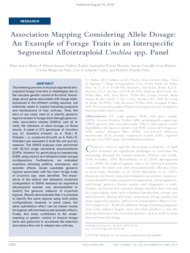Association Mapping Considering Allele Dosage: An Example of Forage Traits in an Interspecific Segmental Allotetraploid Urochloa spp.
Association Mapping Considering Allele Dosage: An Example of Forage Traits in an Interspecific Segmental Allotetraploid Urochloa spp.
Author(s): MATIAS, F. I.; VIDOTTI, M. S.; MEIRELES, K. G. X.; BARRIOS, S. C. L.; VALLE, C. B. do; CARLEY, C. A. S.; FRITSCHE-NETO, R.
Summary: The breeding process in tropical segmental allopolyploid forage Urochloa is challenging due to the complex genetic control of the traits. Knowledge about genes associated with forage traits, expressed in the different cutting seasons, are extremely useful to support breeding programs and development of new cultivars. Thus, the aims of our study were (i) to identify genomic regions related to forage traits through genomewide association studies (GWAS), and (ii) to verify the influence of allele dosage on these results. A panel of 272 genotypes of Urochloa spp. [U. brizantha (Hoscht. ex A. Rich.) R. Webster ´ U. ruziziensis (Hoscht. ex A. Rich.) R. Webster] was evaluated in both the wet and dry seasons. The GWAS analyses were performed with 26,535 single nucleotide polymorphisms (SNPs) obtained by genotyping-by-sequencing (GBS) using diploid and tetraploid allele dosage configurations. Furthermore, we evaluated scenarios including additive, dominance, and epistatic effects. Seven candidate genomic regions associated with the main forage traits of Urochloa spp. were identified. The importance of the diploid and tetraploid molecular configuration in GWAS analyses for segmental allopolyploid species was demonstrated to identify the genomic behavior of important regions. Results demonstrated that it is possible to identify the same regions using both ploidy configurations; however, in some cases, the allele substitution effect can be biased mainly for regions with dominance and epistatic effects. Finally, this study contributes to the understanding of genetic control of tropical forage traits and genomics to accelerate the selection and reduce the cost to release new cultivars.
Publication year: 2019
Types of publication: Journal article
Unit: Embrapa Beef Cattle
Keywords: Animal performance, Animal proteins, Cattle feeding, Forage, Pastures, Tropical regions, Urochloa
Observation
Some of Embrapa's publications are published as ePub files. To read them, use or download one of the following free software options to your computer or mobile device. Android: Google Play Books; IOS: iBooks; Windows and Linux: Calibre.
Access other publications
Access the Agricultural Research Database (BDPA) to consult Embrapa's full library collection and records.
Visit Embrapa Bookstore to purchase books and other publications sold by Embrapa.

